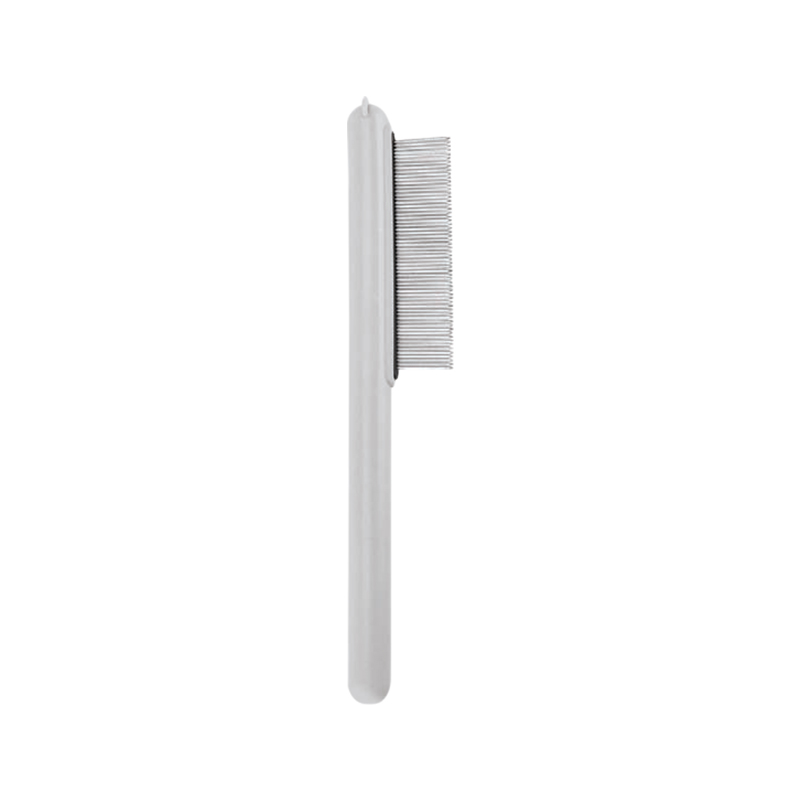Imagine you're preparing your furry friend for a special occasion. How do you transform their coat from tousled to pristine? At that moment, you reach for the perfect tool, and in the center of your grooming arsenal lies the indispensable Pet Grooming Comb, designed to lift, separate, and polish every strand of fur.
1. Clarifying the Need: Why the Pet Grooming Comb is important
Before diving into comb types and their applications, let's address the core question: what makes a comb so critical when brushes already clear away loose hair? By pinpointing this gap, we unlock new levels of pet care, whether in your living room or a professional salon.
Targeted Detangling: Brushes clear surface debris, but combs work deep, teasing out stubborn knots.
Undercoat Access: A comb's teeth penetrate layers to reach hidden mats that can cause discomfort.
Precision Finishing: For that polished sheen and uniform look before photo-ready trims.
2. Step-by-Step Breakdown of a Comb's Functions
Here's a structured dive into how a pet grooming comb works its magic:
Engage and Lift: Starting at the roots, gently insert comb teeth to separate closely packed fur.
Smooth Passage: Glide through the coat, monitoring resistance. Lingering pulls signal knots waiting to be released.
Release and Remove: As teeth emerge, debris and loose hair cling to the comb, ready to be wiped off.
Finish and Shine: A final pass evens out fibers, distributing natural oils for a luminous finish.
3. Types of Combs and Their Strategic Uses
Choosing the right comb pivots on coat type and grooming goals. Below, each comb is linked to its optimal application:
3.1 General Grooming Comb
Design: Dual-tooth sections (wide and narrow spacing) on a sturdy frame.
Use Case: Daily upkeep—removing loose hair and minor tangles in one go.
3.2 Greyhound Comb
Design: Fine, close-set teeth on a long, slender profile.
Use Case: Post-brushing refinement for short-haired breeds or after clipping.
3.3 Fine-Toothed Comb
Design: Ultra-narrow teeth for high-precision work.
Use Case: Scissor and clip prep, ensuring smooth edges and consistent length.
3.4 Face and Eye Comb
Design: Compact with gentle, rounded teeth.
Use Case: Delicate areas around eyes, muzzle, and ears without risking nicks.
3.5 Guide Comb (Clipper Attachment)
Design: Plastic or metal guards fitting standard clipper blades.
Use Case: Controlled trimming for uniform coat length, essential in professional grooming.
3.6 Specialized Innovations: Rotating-Tooth and Static-Control Combs
Rotating-Tooth Comb: Minimizes tugging by allowing teeth to pivot. Ideal for pets sensitive to pulling.
Anti-Static Comb: Engineered teeth reduce static buildup, especially in dry climates or synthetic coats.
4. Materials Matter: From Steel to High-Tech Plastics
Each material brings pros and cons:
Stainless Steel: Durable, easy to sanitize, with precise tooth alignment. Professional salons favor these for longevity.
High-Density Plastic: Lightweight and corrosion-proof. Often treated to minimize static electricity.
Ceramic-Coated Metal: Combines the strength of steel with gentle, heat-retaining properties—especially useful in damp environments.

5. Integrating Current Trends Into Comb Design
Today's pet owners expect tools that blend functionality with smart features:
Ergonomic Handles: Non-slip grips and contoured shapes reduce wrist strain during extended grooming.
Eco-Friendly Materials: Recycled plastics and sustainably sourced metals respond to consumer demand for greener products.
Modular Comb Heads: Interchangeable sections allow rapid swaps between tooth sizes, maximizing versatility.
6. Practical Tips for Effective Combing
Even the best comb falls short without proper technique:
Pre-Brush Preparation: Always start with a de-shedding brush to clear surface debris.
Section the Coat: Divide the coat into manageable strips, especially on long-haired breeds.
Gentle Pressure: Excess force can hurt sensitive skin. Let the comb's teeth do the work.
Regular Maintenance: Clean combs after each use to remove hair buildup and preserve tooth integrity.
7. Linking Technical Detail With Pet-Owner Benefits
Understanding comb mechanics empowers pet owners:
| Feature | Technical Benefit | Owner Outcome |
| Rounded Tooth Tips | Gentle on skin, lower risk of scratches. | Comfortable grooming, happier pets. |
| Varying Tooth Spacing | Adaptable to different coat densities. | One comb suits multiple breeds. |
| Modular Head Attachment | Rapid change between coarse/fine teeth. | Streamlined grooming sessions. |
| Anti-Static Coating | Prevents hair from repelling the teeth. | Less fluff flying around your home. |
8.Elevate the Experience, Elevate Their Comfort
The simple Pet Grooming Comb is far more than a basic accessory. It's a fundamental instrument for maintaining not just your pet's appearance, but their fundamental comfort, skin health, and overall well-being. In today's world, where pets are integral family members, providing this level of attentive care is non-negotiable. It's about preventing the hidden discomfort of mats, ensuring skin health through close inspection, and distributing those essential natural oils for vitality. Choosing tools crafted with care, designed for safety and effectiveness, reflects the love and commitment we have for our furry companions. Discover the difference that precision grooming with the right comb can make – it's the silent promise of comfort and care you make with every stroke. Explore thoughtfully designed options that prioritize your pet's experience, because they deserve tools as exceptional as they are.
 English
English 中文简体
中文简体 русский
русский

